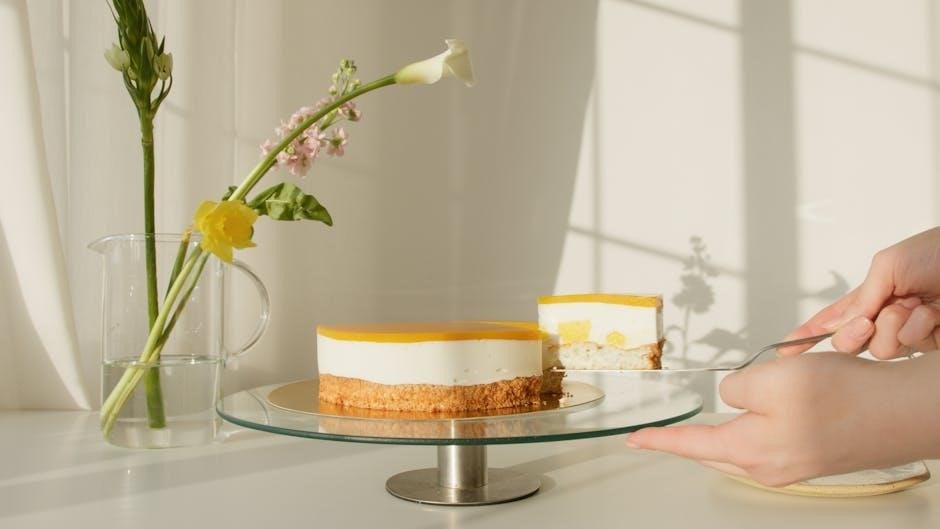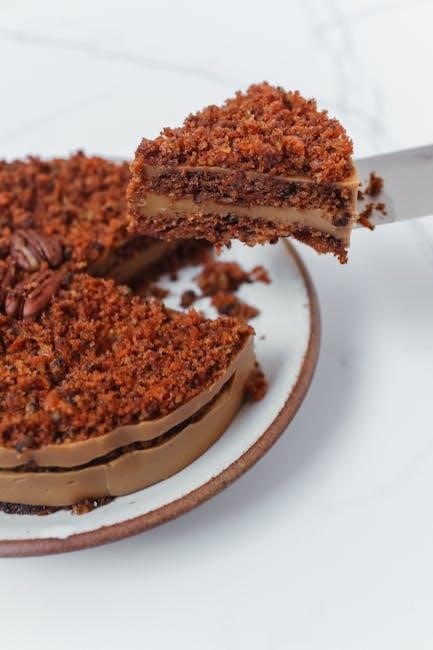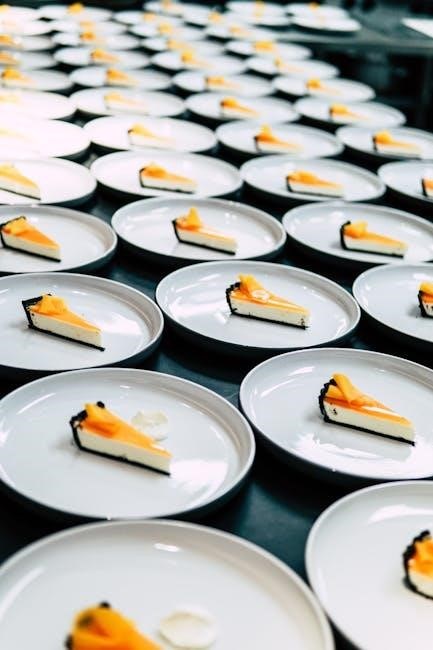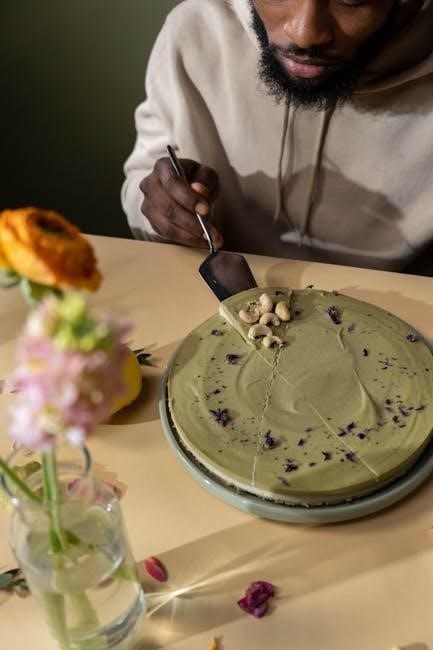Understanding cake serving sizes is essential for ensuring every guest receives a fair portion; Guides offer insights into portion control, helping plan the right cake size for events.
1.1 Understanding the Importance of Portion Control
Portion control is vital for ensuring fairness and minimizing waste. It helps determine the right cake size for events, preventing under-serving or over-serving. Using cake serving charts and guides, you can accurately estimate servings based on cake dimensions and cutting styles. This is especially crucial for weddings and large gatherings, where precise planning is essential. Understanding portion control also helps balance decorations and servings, ensuring both aesthetics and guest satisfaction. It avoids scenarios where too much cake goes uneaten or guests are left without a slice. Proper portioning is key to a successful and stress-free event.
1.2 Brief Overview of Cake Serving Guides
Cake serving guides provide structured frameworks to determine how many servings a cake can yield. These guides typically account for factors like cake shape, size, and cutting style. They often include charts or tables that correlate cake dimensions to serving numbers, helping bakers and event planners prepare accurately. Serving guides are especially useful for events requiring precise portioning, such as weddings or large gatherings. By following these guides, hosts can ensure fair distribution, minimize waste, and meet guest expectations. They also offer flexibility, accommodating different event needs and cake types, whether it’s a tiered masterpiece or a simple celebration dessert.

Factors Influencing Cake Serving Sizes
Cake shape, serving style, and cutting techniques significantly impact serving sizes. These factors determine how many portions can be fairly and evenly distributed to guests.
2.1 Cake Shape and Its Impact on Servings
Cake shape significantly influences serving sizes, as different shapes yield varying portion counts. Round cakes, for instance, are straightforward to calculate, with servings based on diameter and height. Square or rectangular cakes often serve more due to their larger surface area, while tiered cakes allow for multiple serving sizes across layers. The shape also affects how the cake is cut and presented, impacting portion consistency; Understanding these differences is crucial for accurately determining how many guests a cake can serve, ensuring no one is left without a slice. This variability highlights the importance of considering shape when planning cake sizes for events.
2.2 Serving Styles: Wedding vs. Celebration Cakes
Serving styles differ significantly between wedding and celebration cakes due to their purposes and guest expectations. Wedding cakes are typically designed for precise portion control, with smaller, uniform slices to ensure equal servings for all guests. This formal approach aligns with the structured nature of weddings. In contrast, celebration cakes often feature larger, more generous portions, catering to casual gatherings where seconds are common. The cutting style for weddings may involve a specific pattern to achieve uniformity, while celebration cakes might be cut in a less formal manner, prioritizing ease and quick service. These differences reflect the distinct atmospheres and needs of each event type.
2.3 How Cutting Styles Affect Portion Sizes
Different cutting styles significantly influence cake portion sizes. The most common method is the grid cut, which divides the cake into equal squares or rectangles, ensuring uniform servings. Radial cutting, slicing from the center outward, can create larger portions but may lead to uneven distribution. Spiral cutting, often used for tiered cakes, balances aesthetics with consistent portion sizes. Thicker slices provide more generous servings, while thinner cuts maximize the number of portions. The choice of cutting style must consider both the event’s formality and the desired serving size, ensuring that each guest receives an equitable share without compromising the cake’s presentation.

Standard Cake Serving Sizes
Standard cake serving sizes vary by shape and size, with round cakes typically serving 8-12 people per 8-10 inch diameter, while square cakes serve 9-12 per 8×8 inches.
3.1 Round Cakes: Servings by Inches
Round cakes are a popular choice, and their serving sizes are determined by diameter. A standard 8-inch round cake typically serves 8-10 people, while a 9-inch serves 10-12. Larger cakes, such as 10-inch, can serve 12-15, and 12-inch cakes serve 15-20. These estimates assume standard 1×2-inch slices. For smaller gatherings, a 6-inch cake serves 4-6 people. Serving sizes may vary based on how generously slices are cut. Wedding cakes often use a more precise formula, calculating servings by the cake’s area divided by 2.5 square inches per serving. Always consider the event type and appetite when planning cake size.
3.2 Rectangular and Square Cakes: Servings by Dimensions

Rectangular and square cakes offer flexibility in portioning due to their uniform shape. A standard 9×13-inch cake typically serves 12-15 people, while an 8×8-inch square cake serves 9-12. Servings are calculated by dividing the cake’s area into 2×1-inch slices. For example, a 10×10-inch square cake has an area of 100 square inches, yielding 40 servings (100 ÷ 2.5 square inches per serving). Rectangular cakes, like 11×15 inches, serve 15-20 people. Square cakes often mirror round cakes in servings per inch of diameter. Cutting style and slice size can adjust these estimates, making rectangular and square cakes versatile for various events. Planning ahead ensures accurate portioning for your gathering.
3.3 Tiered Cakes: Calculating Servings for Multi-Layer Cakes
Calculating servings for tiered cakes involves determining the number of slices for each layer individually and then summing them up. Start by measuring the diameter or dimensions of each tier. For round tiers, calculate the area using the formula πr², where r is the radius. For square or rectangular tiers, multiply length by width. Assume a standard serving size of 1×2 inches per slice. Divide the total area of each tier by the serving size to estimate servings. For example, a 12-inch round tier has an area of 113.1 square inches, yielding approximately 45 servings (113.1 ÷ 2.5 square inches per serving). Sum the servings from all tiers to get the total number of portions. Remember, the top tier is often reserved, so adjust the total accordingly. Using this method ensures accurate portioning for any celebration.
Wedding Cake Serving Guide
A wedding cake serving guide helps determine the perfect cake size for your guest list, offering popular tier combinations and serving charts to ensure every guest is accommodated.

4.1 Determining the Right Cake Size for Your Guest List
Determining the right cake size for your guest list involves calculating servings based on the number of attendees. A general rule is to plan for 2-3 servings per guest, depending on serving style and appetite. For example, a 100-guest wedding typically requires a cake serving 100-120 people. Consider the cake’s height and tier structure, as taller cakes may yield more servings. Use a cake serving chart to match guest count to cake dimensions. Factor in additional servings for seconds or leftovers. Consulting with your baker ensures the cake meets your needs without excess or shortage, creating a stress-free experience for your special day.
4.2 Popular Tier Combinations for Weddings
Popular tier combinations for weddings vary based on guest count and design preferences. A classic three-tier cake is ideal for 100-300 guests, with tiers measuring 6″, 8″, and 10″ in diameter. For larger events, a four-tier cake (6″, 8″, 10″, 12″) serves 300-500 guests. Five-tier cakes (6″, 8″, 10″, 12″, 14″) are perfect for grand weddings with 500+ attendees. Many couples opt for a smaller top tier for a romantic touch. These combinations balance aesthetics and functionality, ensuring every guest enjoys a slice. They also allow for creative decorating while maintaining structural stability, making them a timeless choice for weddings of all sizes.
4.3 Using a Wedding Cake Servings Chart
A wedding cake servings chart is a valuable tool for planning the perfect cake size. It typically lists cake dimensions, number of tiers, and corresponding servings. For example, a 6-inch tier serves 12-15 guests, while a 12-inch tier serves 60-70. Charts also account for cake shape, with round cakes offering more servings than square ones. Couples can use these charts to match their guest list to the right cake size. They ensure no one goes without a slice and prevent wasted cake. Many charts include visuals, making it easier to visualize the cake’s appearance and portion distribution. This resource is essential for stress-free wedding cake planning.

Party and Celebration Cake Guide
This guide helps select the perfect cake size for parties, ensuring enough servings for all guests while accommodating different themes, preferences, and celebration styles effortlessly and enjoyably.
5.1 How to Choose the Right Cake Size for Parties
Choosing the right cake size involves considering guest count, serving preferences, and cake shape. Start by estimating servings needed, adding 10-15% for extras. Round cakes typically serve 8-12 per 8-inch layer, while square cakes offer more portions due to straight edges. Cutting style matters—thin slices yield more servings. Opt for larger cakes if expecting hearty appetites or multiple helpings. Use a serving chart to match cake dimensions to guest numbers. Ensure the cake’s design aligns with the party’s theme without compromising portion sizes. This approach ensures everyone enjoys a fair share, making your celebration both memorable and satisfying.
5.2 Serving Sizes for Different Party Themes
Party themes influence serving sizes, as they dictate guest expectations and portion preferences. Formal events often require smaller, bite-sized servings (1×1 inches), while casual gatherings may allow for larger slices (1.5×1.5 inches). For children’s parties, fun shapes like cupcakes or cookie cakes are popular, with servings sized for smaller appetites. Themed parties, such as holiday or seasonal celebrations, might feature uniquely shaped cakes, but standard serving sizes typically apply. Decorations and presentation should align with the theme without compromising portion consistency. Adjusting serving sizes based on the event’s style ensures a balanced and enjoyable experience for all attendees, keeping the celebration festive and satisfying.
5.3 Adjusting for Large Events or Gatherings
For large events or gatherings, scaling up cake size and servings is essential to accommodate the increased guest count; A general rule is to increase portions by 10-15% to account for varied appetites and second helpings. Consider using tiered cakes or multiple smaller cakes to distribute evenly. Practical solutions include pre-cutting slices for faster service or setting up designated serving stations to avoid bottlenecks. Additionally, offering a variety of flavors or complementary desserts can reduce pressure on a single cake. Always plan for a few extra servings to ensure no guest is left without a slice, balancing generosity and practicality effectively.

Holiday and Specialty Cake Servings
Holiday and specialty cakes often require tailored serving strategies due to unique shapes, sizes, and decorative elements. Seasonal themes and creative designs influence portion sizes and presentation.
6.1 Serving Sizes for Seasonal Cakes

Holiday and seasonal cakes often have unique serving size requirements due to their shapes, designs, and portion expectations. For example, Christmas cakes may be larger to accommodate big gatherings, while Halloween cakes might be smaller, focusing on individual servings. Wedding cakes in spring or summer may require precise portion control to match guest counts. Seasonal themes can also influence serving styles, such as cutting smaller slices for decorative purposes. Understanding these variations helps in planning the right cake size for festive events, ensuring every guest enjoys a satisfying portion without wasting.
6.2 Specialty Cakes: Adjusting Servings for Unique Shapes
Specialty cakes with unique shapes, such as hexagons, ovals, or asymmetrical designs, require careful adjustment of serving sizes. Unlike standard round or square cakes, these shapes don’t fit traditional serving charts, making portion calculation challenging. To ensure accurate servings, bakers often use specialized calculators or measure the cake’s total volume. For instance, a hexagonal cake may yield fewer servings than a round cake of the same diameter due to its shape. Understanding the cake’s dimensions and using visual guides can help determine the right portion sizes, ensuring every guest receives a fair share without compromising the cake’s aesthetic appeal.
6.3 Holiday Portion Trends
Holiday portion trends often influence how cakes are served, with seasonal celebrations dictating serving sizes. During holidays like Christmas or Thanksgiving, smaller slices are common due to richer meals. Conversely, events like weddings or New Year’s parties may feature larger portions to match the festive atmosphere. Seasonal cakes, such as Halloween-themed or Easter-inspired designs, may have servings adjusted based on their decorative complexity. Additionally, cultural traditions play a role, with certain holidays requiring specific portion sizes. Understanding these trends helps bakers tailor their cakes to meet expectations, ensuring both flavor and presentation align with the occasion’s spirit while satisfying guests’ appetites.

Tools and Resources for Calculating Cake Servings
Utilize cake serving charts, baking apps, and visual aids to determine accurate portion sizes and ensure enough cake for every guest, saving time and stress.
7.1 Cake Serving Charts and Portion Guides

Cake serving charts and portion guides are essential tools for determining the right size and number of servings. These resources provide detailed measurements and calculations based on cake shape, size, and type. Round, rectangular, and tiered cakes each have specific guidelines to ensure accurate portioning. Many charts include visual diagrams, helping bakers and planners visualize how to cut servings evenly. Portion guides often account for factors like guest appetite and event type, offering tailored suggestions. By using these tools, you can avoid under-serving or over-serving, ensuring every guest enjoys a consistent and satisfying slice of cake at weddings, parties, or special events.
7.2 Baking Apps for Calculating Cake Sizes
Baking apps are invaluable for calculating cake sizes and servings with precision. These apps often feature cake size calculators, allowing users to input dimensions, shapes, and serving sizes to determine the perfect cake proportions. Many apps offer real-time adjustments, enabling bakers to tweak recipes based on the number of guests or ingredient availability. Popular apps like Cake Size Calculator and BakeMate provide user-friendly interfaces for quick calculations. They also include features like conversion tools and recipe scaling, making them indispensable for both amateur bakers and professionals. By leveraging these digital tools, bakers can ensure accurate portioning and stress-free preparation for any event.
7.3 Using Visual Aids to Explain Cake Sizes
Visual aids like charts, diagrams, and images are excellent for helping customers understand cake sizes and servings. A cake size chart can visually represent how servings vary by cake dimensions, making it easier to compare options. High-quality images of sliced cakes demonstrate portion sizes, while infographics can break down servings by tiers or shapes. Videos showcasing cake cutting techniques also clarify how servings are calculated. Digital displays in bakeries or online platforms can further enhance customer understanding. These tools not only simplify decision-making but also build trust by providing clear, relatable information. Visual aids are particularly helpful for non-visual learners and those planning large events.
Explaining Cake Sizes to Customers
Clear communication about cake sizes ensures customers understand portion options. Use simple language, visual aids, and examples to convey serving capacities effectively, building trust and satisfaction.
8.1 Effective Communication About Portion Sizes
Effective communication about portion sizes is crucial for managing customer expectations. Be clear and transparent when explaining how many servings a cake can yield. Avoid using overly technical terms and instead use relatable examples, such as comparing servings to standard slice sizes. Provide visual aids like charts or images to illustrate portion sizes. Emphasize that serving sizes can vary based on individual appetites and event types. Encourage customers to ask questions and confirm their needs before finalizing an order. Clear communication ensures satisfaction and builds trust, helping customers feel confident in their cake choices for events like weddings, parties, or celebrations.
8.2 Using Pictures and Charts for Clarity
Visual aids like pictures and charts are invaluable for explaining portion sizes. Show images of actual cake slices to help customers visualize serving sizes. Charts can display cake dimensions, serving numbers, and portion estimates side by side. For example, a chart might show an 8-inch round cake serving 8-10 people, with slices cut in uniform sizes. This clarity reduces confusion and helps customers make informed decisions. Use high-quality images and simple, easy-to-read charts. Visual aids also save time during consultations, ensuring everyone understands the options. They are especially helpful for non-visual learners and those planning large events like weddings or corporate gatherings.
8.3 Addressing Customer Questions About Servings
Addressing customer questions about servings requires clear, patient communication. Start by understanding their event details, such as guest count and serving preferences. Provide specific examples, like the number of slices per cake size, to help them visualize. Answer common questions, such as whether a 10-inch cake serves 20 people or if servings vary by slice size. Offer recommendations based on their needs, like suggesting a larger cake for generous portions or a smaller one for lighter servings. Reassure them by explaining how you calculate servings to ensure everyone is satisfied. This approach builds trust and confidence in their decision-making process.
Strategies for Ensuring Enough Cake
Estimate guest count accurately and add a 10-15% buffer for unexpected servings. Consider appetites and event timing. Opt for slightly larger cakes to avoid shortages and ensure everyone enjoys a slice.
9.1 Calculating Servings Based on Guest List
To ensure enough cake, start by estimating the number of guests and their serving preferences. Consider the type of event and serving style, as dessert portions differ from coffee or wedding servings. Add a 10-15% buffer to the guest count to account for unexpected servings or larger appetites. For round cakes, estimate servings based on diameter and height, while square or rectangular cakes use length and width. Tiered cakes require calculating each layer separately. Use online cake serving charts or calculators for precise numbers. This approach guarantees every guest enjoys a slice, balancing generosity with practicality for a memorable celebration. Proper planning prevents shortages and ensures satisfaction.
9.2 Accounting for Seconds and Leftovers
Accounting for seconds and leftovers ensures every guest can enjoy additional servings without running out of cake. Add 10-15% to your guest count for potential seconds, especially for events with hearty appetites or longer celebrations. Consider the cake’s appeal and serving style—rich cakes might yield fewer seconds, while lighter options may encourage more. Plan leftovers by portioning uneaten cake into smaller slices or packaging for guests to take home. This approach not only satisfies cravings but also minimizes waste, ensuring your event is both generous and efficient. Proper planning balances guest satisfaction with practical resource management, making your celebration memorable and stress-free.
9.3 Tips for Avoiding Under or Over-Serving
To avoid under or over-serving, start by using a reliable cake serving chart to estimate portions based on size and shape. Measure and cut slices consistently, using a serrated knife for clean cuts. Pre-cutting cakes ensures even distribution and prevents last-minute rush. Offer smaller slices for variety or larger ones for hearty eaters. Consider guest preferences, like dietary restrictions, to adjust serving sizes. Use serving utensils or markers to guide portioning. Finally, monitor servings as the event progresses to ensure everyone gets their fair share without excess. These strategies help maintain balance, ensuring satisfaction and minimizing waste effectively at your gathering.
Best Practices for Cake Portioning
Adopt consistent cutting techniques, use tools like serrated knives and portion guides, maintain hygiene, and ensure clean presentation for even, appealing portions every time.
10.1 Consistent Cutting Techniques
Consistent cutting techniques ensure uniform portion sizes and an attractive presentation. Use a serrated knife or cake cutter for clean, even slices. Always level the cake before cutting to maintain balance. Measure and mark the cake surface to guide precise cuts. For round cakes, slice in a radial pattern, while rectangular cakes are best cut into equal-sized rectangles. Apply gentle, even pressure to avoid crumbling. Sanitize tools between cuts to maintain hygiene. Consistent techniques guarantee professional results, ensuring each serving is visually appealing and fairly portioned. This approach also helps in managing serving sizes accurately, making it easier to meet guest expectations.
10.2 Balancing Decorations and Servings
Balancing decorations and servings is crucial for both aesthetics and portion control. Elaborate designs or large toppers may reduce the number of servings, so plan accordingly. Decorations like flowers, borders, or writing should be proportional to the cake size. Over-decorating can make slices appear smaller, while minimal designs maximize serving potential. Consider the design’s impact on cutting; for example, asymmetrical decorations may require adjusting slice sizes. Ensure decorations are secure and evenly distributed to maintain portion consistency. Striking this balance ensures your cake is both visually stunning and serves the intended number of guests without compromise.
10.3 Maintaining Hygiene in Portioning
Maintaining hygiene in portioning is essential to ensure safety and quality. Always use clean, sanitized utensils and cutting tools when slicing cake. Hands should be washed thoroughly before handling the cake, and gloves can be worn for extra precaution. The cutting surface must be clean and free from contaminants. Regularly sanitize tools and surfaces, especially between cuts, to prevent cross-contamination. Store uneaten cake in airtight containers at the appropriate temperature to maintain freshness. Proper hygiene practices not only safeguard health but also preserve the cake’s appearance and flavor. A clean environment and tools are vital for professional and home cake portioning.

